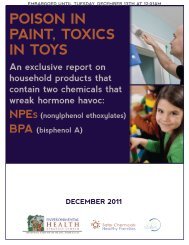POISON IN PAINT, TOXICS IN TOYS - HealthyStuff.org
POISON IN PAINT, TOXICS IN TOYS - HealthyStuff.org
POISON IN PAINT, TOXICS IN TOYS - HealthyStuff.org
You also want an ePaper? Increase the reach of your titles
YUMPU automatically turns print PDFs into web optimized ePapers that Google loves.
<strong>POISON</strong> <strong>IN</strong> PA<strong>IN</strong>T, <strong>TOXICS</strong> <strong>IN</strong> <strong>TOYS</strong><br />
An exclusive report on household products that<br />
contain two chemicals that wreak hormone havoc:<br />
NPES (nonylphenol ethoxylates)<br />
BPA (bisphenol A)<br />
Executive Summary<br />
For the �rst time more than 650 brand name<br />
household products that contain one of two<br />
toxic chemicals of high concern, NPEs (nonylphenol<br />
ethoxylates) and BPA (bisphenol A), have been<br />
publicly identi�ed. Twenty-�ve manufacturers<br />
reported their use of NPEs and BPA in consumer<br />
products sold in Maine under a 2008 state law on<br />
chemical safety.<br />
State chemical policies are a proven, e�ective means<br />
for gathering previously unavailable information<br />
on chemicals used in everyday products. Most<br />
manufacturers reported NPEs in household paints<br />
(291 products) and BPA in plastic toys (280 products).<br />
NPEs were also reported in 61 other home maintenance<br />
products (such as cleaners and wood stains) and 14<br />
personal care products (i.e. antiseptic iodine solution<br />
and hair care products). For speci�c brand name<br />
product results, visit www.HealthyStu�.<strong>org</strong>.<br />
Studies have shown that BPA and NPEs mimic the sex<br />
hormone estrogen. BPA harms brain development,<br />
behavior and the prostate gland, among many<br />
other adverse health e�ects. NPEs are highly<br />
toxic to aquatic life, degrade into a long-lived<br />
chemical that builds up in the food chain, and may<br />
harm reproduction and development in humans.<br />
Aggregate exposure to BPA and NPEs from all sources<br />
Introduction<br />
More and more states are enacting laws to protect<br />
the health of American families from toxic chemicals<br />
because our federal chemical safety system is so badly<br />
broken. In the last decade, 18 states have passed more<br />
than 70 laws to ban chemicals in products or create<br />
new chemical management programs at the state level.<br />
Four states, so far, have passed comprehensive chemical<br />
threatens the health of children, workers and the<br />
environment.<br />
New information on chemical use in household<br />
products will improve decisions to protect family<br />
health and the environment. Government agencies<br />
and manufacturers can decide to study exposure,<br />
search for safer alternatives or phase out use of<br />
the chemical. Consumers and retailers can avoid<br />
chemicals of high concern when they purchase<br />
everyday products.<br />
Some companies are apparently not reporting<br />
chemical use as required by Maine law. For example,<br />
manufacturers failed to report BPA use in baby<br />
food in the lining of the metal lids of glass jars.<br />
Other companies have already switched to safer<br />
alternatives. For example, most manufacturers have<br />
recently ended BPA use in infant formula can linings.<br />
This report reveals a badly broken federal safety<br />
system that still allows the widespread use of toxic<br />
chemicals in consumer products. To protect public<br />
health and ensure product safety, Congress should<br />
pass the Safe Chemicals Act of 2011 to overhaul the<br />
Toxic Substances Control Act (TSCA), which has never<br />
received a major update in 35 years.<br />
policies: California, Maine, Minnesota and Washington.<br />
While Congress lags behind on TSCA reform, state<br />
chemical safety laws are working. 1<br />
Under Maine’s 2008 Kid Safe Products Act,<br />
manufacturers must disclose the use of priority<br />
chemicals of high concern in consumer products.<br />
DECEMBER 2011 1




